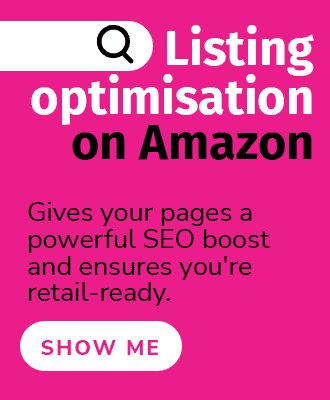If you’re new to Amazon or already selling but still woefully in the dark about how to utilise the platform effectively, the endless jargon can sometimes feel overwhelming. Some confusing features and acronyms you may encounter on your seller journey include terms like Buy Box, A+ Content, BSR, and FBA, all of which sit on the product detail page (PDP).
A PDP is a catch-all web page designed to provide customers with everything they need to know about that particular product, including model numbers, pricing information, videos, advertisements, seller information, product photographs and more. Every product sold on Amazon has a PDP. If you are a seller or vendor in any locale and your product has been created in the Amazon catalogue, your item will sit on a PDP.
Every feature of the PDP is designed to showcase your product. The Amazon A10 algorithm (A10) places a high value on sales generated through organic search results rather than paid ads. It considers reviews, ratings, SEO, sales history, fulfilment methods and performance to ensure customers have the most accurate results to meet their needs. If you optimise your PDP correctly, the A10 will index your product more highly, improving your visibility and ranking on the search engine results page (SERP).
If you’re still scratching your head, fear not; here’s our rundown of the Amazon product detail page. We’ll detail the significance of each feature and help you make your product listing more than the sum of its parts.
Decoding the Jargon
First, let’s go over the basic anatomy of the product detail page.

This image demonstrates the various components that are immediately and universally visible to customers and sellers on a PDP beneath the global navigation on the Amazon desktop site. It’s worth noting that this is structured slightly differently on mobile devices or in the Amazon app, but the same information will still be present. Features include:
- ASIN (Amazon Standard Identification Number): Each product's unique ASIN is hidden in the search bar. This unique identifier is essential for managing and selling your products. Without it, you can’t create your PDP, as the ASIN links it to the specific product it represents. ASINs can also help manage product variations, link to customer reviews, and play a significant role in inventory management; allowing sellers to track inventory levels and ensure their products are in stock.
- Title: The title is your first opportunity to make your product stand out. Your brand name goes up front, followed by your primary keyword (high-volume and super specific) and other essential attributes, features, and related keywords. This prime real estate is one of the most significant factors affecting how you index in the A10’s algorithm and, therefore, your discoverability in the SERP. Effectively optimising your title will not only impact your product's visibility, potentially appearing at the top of SERP, but a compelling title can also increase click-through rate (CTR), product understanding, and sales. A well-crafted title can also improve your brand’s credibility, resulting in greater brand loyalty and repeat customers.
- Main images: If done well, the main product images can be a persuasive sales tool that delivers eye-catching, attention-grabbing aesthetics. Your main product images will be one of the first things a customer explores, so it’s essential to ensure these follow the Amazon guidelines and deliver professional, engaging, high-quality results. Main images also provide an opportunity to communicate more details about the product, USPs, and benefits, through well-executed infographics that set you apart from the competition.
- Variations: If you have a range of identical products that differ only by size, flavour, pack size, or colour, here’s where you get to showcase the child ASINs. By grouping variations under a single parent ASIN, you can easily organise and manage inventory; it also creates a convenient navigational shortcut for the customer who only needs to click the drop-down to select the colour/size/quantity they need. Each child variation will also share the same reviews and ratings on the PDP; consolidating this feedback helps build trust and can be advantageous when launching a new variation.
- Bullet points: For sellers, five bullets are allowed; for vendors, seven bullets are allowed. The bullet points provide a significant opportunity to showcase your product's unique USPs in a succinct and easily digestible manner. Ensure you break everything down into scannable, concise snippets, highlight the key product features, and optimise the copy with SEO-friendly, relevant keywords. The A10 scans the bullets for keywords and will index and rank your product accordingly. Well-written, optimised bullets can significantly improve your position in the SERP.
If you are already selling on Amazon, you might see some familiar content replication from the backend of a product’s listing and this customer-facing detail page. Much of the content you enter in either Seller Central or Vendor Central pulls through to the PDP.

- Product description: You can go into more comprehensive detail about your product and company in this section whilst ensuring the copy is optimised for SEO. Expand beyond the bullet points and images with thorough explanations about the product’s features and USPs. Well-crafted, fully-optimised product descriptions can be persuasive and set you apart from competitors. Expanding upon your product's specifications and anticipating customer questions will remove any doubts about the product and help convince potential shoppers that yours is the one to buy.
- A+ Content: This feature is only accessible for brands registered on Brand Registry. A+ Content allows an expanded product description to exist on the item’s PDP, making room for more text, lifestyle images, graphic design, a brand story, and more. A+ Content enhances your brand identity, builds brand recognition, and fosters customer loyalty. It allows you to include enhanced visuals, graphics, charts and, with A+ Premium, interactive modules. Presenting this new information in a visually captivating format helps differentiate your product from competitors and provides you with an opportunity to cross-sell and upsell products within your broader range. According to Amazon, A+ Content can improve conversion rates by up to 10%. Although the A+ Content won’t index for the A10 algorithm, it will index on Google, which can increase external traffic to your PDP.
As you scroll further down the PDP, you'll see all the remaining relevant features that can impact a customer’s buying decision.

- Manufacturing and technical information: Listing your product’s manufacturing and technical information is a no-brainer. Potential buyers will want to know where the product was made, specifications, production details, and materials used. All these pieces will help customers determine whether this product suits their needs and whether they’ll go ahead with the purchase. By including accurate information, you lessen the risk of returns and increase the likelihood of positive reviews.
- BSR (Best Sellers Rank): This clever little gauge is a significant barometer for many customers. The BSR indicates how popular your product is within its category, compared to like products sold by competitors. The lower the BSR, the higher the sales and demand. When consumers see a low BSR, it bolsters their confidence in the product, assuming it must be a quality item if many other customers have bought it. The BSR is also useful for sellers to track their product’s progress within a specific category, monitor market trends and adjust pricing strategies by taking an overview of the competitor landscape. The A10 algorithm also considers the BSR when determining your product's visibility in the SERP.
It’s important to note that your BSR is category-specific and will frequently change depending on seasonal fluctuations and competitor performance.
- Q and A’s: Q and A’s are another crucial way for sellers to engage with potential customers by providing invaluable insights and addressing customer concerns, increasing seller credibility and, in turn, conversion rates. Ensure you answer any questions thoroughly with as much detail as possible.
- Customer reviews and star rating: Amazon customers LOVE to give feedback. Your star rating and volume of positive/negative reviews can really make or break your product. All that data goes into the A10 algorithm’s analysis of what kind of service your customers receive and how reputable your brand is. These variables impact not only your discoverability on the SERP but also the customer’s opinion on whether you’re the kind of seller they can trust.
- Amazon ads: Amazon advertisements appear at various places on the PDP. Sellers can target these ads by product category, keyword, location, etc. By running ads on the PDP, you increase the visibility of your product. You can target customers who are already interested in the product and are more likely to purchase. Amazon ads give you a competitive advantage to help your product stand out and increase brand awareness.
Top tip: Some rules for your PDP content will differ depending on whether you are a seller or vendor and what country you are listing your product in. In general, the US Seller Central detail page guidelines and UK Seller Central detail page guidelines are good starting points.
Now that we’ve got the basics of the PDP under our belts, we can start looking at other interesting PDP features.
What is FBA?
FBA, aka Fulfillment by Amazon, is a service offered by Amazon that allows sellers to store their products in Amazon's fulfilment centres. Once a customer has purchased an item from an FBA seller, Amazon takes care of everything, from packaging to shipping to customer service. FBA can be very useful for sellers as it also unlocks access to Amazon's Prime members, who often prioritise FBA products over competitors. By enrolling in FBA, you also access Amazon’s expansive logistics infrastructure, ensuring your customers receive fast and reliable shipping and impeccable customer service, including easy returns. When a seller chooses FBA, it also positively impacts the A10 algorithm’s analysis of the PDP, which can have other benefits, including helping the seller become eligible for the Buy Box….
What is the Buy Box?
The Buy Box (when it’s present) is the primary source of sales on both desktop and mobile devices. Over 80% of total Amazon sales happen through that magical box, so if it’s missing, it will seriously impact your chances of making a sale. A highly sought-after feature, its prominence on the PDP makes it a default customer purchasing option.
Essentially, the Buy Box is a shortcut to sales. It simplifies purchasing activity with the ‘Add to Cart’ and ‘Buy Now’ buttons to expedite customer spending. When a buyer selects “Add to Cart”, the seller who has the Buy Box at that moment gets the sale.
Eligibility is determined by the A10 algorithm, taking into account variables such as positive customer reviews, your fulfilment method, your pricing, and the optimisation of your content. If you’re curious to know more, head over to The case of the missing Buy Box.
Is there a right way to optimise your PDP?
Whilst you want to include essential information, such as a title, bullets, images and a product description, there is an art to doing it correctly. At eCommerce Nurse, our content team of expert marketing specialists creates listing optimisations that are on-brand, localised, and within Amazon’s content guidelines, no matter where or what you’re selling. We do this with a proven, SEO-based approach, whether overhauling existing listings or starting from scratch.
Optimised product detail pages can:
- Increase your SEO and sales organically.
- Help sales take off and climb the rankings for new products.
- Create brand awareness and drive customer loyalty.
- Improve your profits and boost conversion.
- Make your PPC advertising more effective and less expensive.
- Help you avoid common mistakes on your detail page.
Get in touch
If you are struggling to optimise your product detail page, looking to integrate A+ Content, or would like a comprehensive approach to your brand presence on Amazon, eCommerce Nurse can help. Get in touch today.




